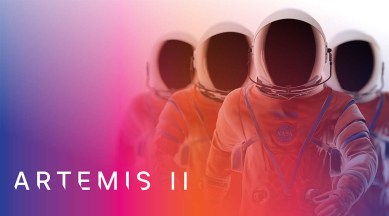NASA’s Artemis II astronauts to be announced on Tuesday: Everything we know about the mission
NASA and the Canadian Space Agency are set to announce the four astronauts for the Artemis 2 mission. Here is everything you need to know about the mission and how to live stream the announcement.

After the success of the Artemis 1 mission, NASA is going full steam ahead on its path to putting humanity back on the Moon. The space agency is set to announce the four astronauts who will be part of the Artemis 2 mission on Monday, April 3.
NASA and the Canadian Space Agency will begin live streaming the event at 8.30 PM IST on Monday, April 3. You can watch it in the window below or on NASA’s website. The space agency initially planned to launch the mission towards the end of 2024, but it might get pushed to 2025.
monthly limit of free stories.
with an Express account.
With the uncrewed Artemis 1 mission, NASA tested the foundations of Its new human space exploration capabilities, including the Space Launch System (SLS) rocket, Orion spacecraft, and all associated ground systems. Artemis 2 will be the first crewed mission to test these.
During the 10-day-long mission, the four astronauts will fly around the Moon to test and stress Orion’s life-support systems to make sure that it is capable of supporting astronauts to live and work in deep space.
Artemis 2 mission overview
After launching from the Kennedy Space Center in Florida using the SLS rocket, Orion will go through multiple manoeuvres to raise its orbit around Earth. Eventually, it will place the crew on a “lunar free return trajectory,” where Earth’s gravity will naturally pull the spacecraft back home after flying by the Moon.
Artemis 2 launch and Earth orbit
The initial launch will be similar to what happened during the Artemis 1 mission. After that, the crewed Orion and the ICPS (interim cryogenic propulsion stage or upper stage) of the rocket will orbit Earth twice. This is to make sure that all of the spacecraft’s systems are working while it is still close to the Earth.
The first orbit will be an elliptical one that will take the spacecraft as far as 2,900 kilometres away from the planet. This will last a little over 90 minutes. The second orbit will also be elliptical but it will be a much larger ellipse, taking the spacecraft as far as 74,000 kilometres away from the planet. The second orbit will last for about 23 and a half hours.
To put those distances into context, the International Space Station orbits about 400 kilometres above our planet.
Orion will enter the second high-Earth orbit using ICPS propulsion and will separate from that stage after completing the manoeuvre. After this, the astronauts will conduct a “proximity operations demonstration” before taking off their bright orange Orion spacesuits. They will continue the mission in plain clothes till it is time to re-enter Earth’s atmosphere.
Artemis 2’s journey to the Moon and back
The astronauts will then travel about 10,300 kilometres past the far side of the Moon. From there, they will be able to see both the Earth and the Moon. The Moon will be in the close foreground while the Earth will be more than 400,000 kilometres in the background.
Interestingly, because of the lunar free return trajectory, Orion will not need any propulsion on its return journey. It will take advantage of the Earth-Moon gravity field to ensure that our planet’s gravity will naturally pull it back.